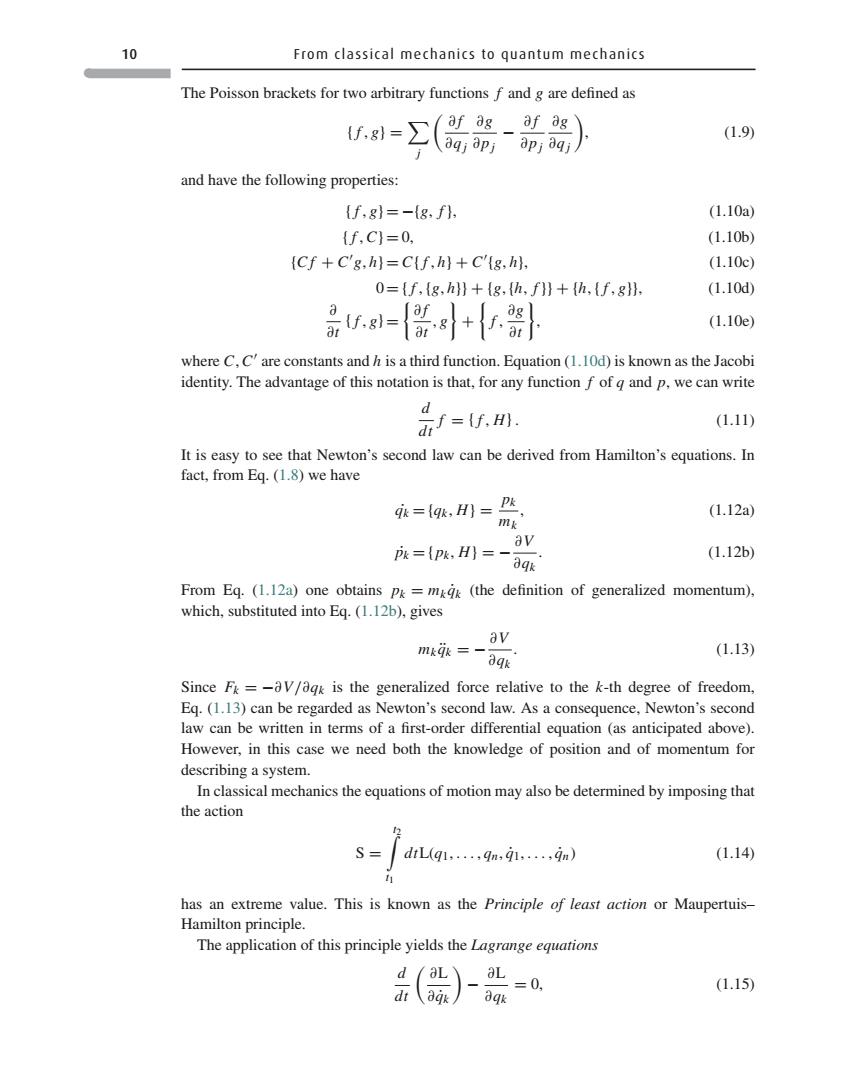正在加载图片...

10 From classical mechanics to quantum mechanics The Poisson brackets for two arbitrary functions f and g are defined as -(器-影) (1.9 and have the following properties: U,g1=-{g,f. (1.10a) f,C1=0, (1.10b (Cf +C'g.h)=C(f.h)+C'(g,h). (1.10e 0=f,g,h}+{g,h,f》+h,{f,g, (1.10d 品.e={影8+{} (1.10e) where C.C'are constants and h is a third function.Equation(1.10d)is known as the Jacobi identity.The advantage of this notation is that,for any function f of g and p,we can write d f=(f.H (1.11 It is easy to see that Newton's second law can be derived from Hamilton's equations.In fact,from Eq.(1.8)we have =你,=器 (1.12a A=n训=兴 (1.12b) From Eq.(1.12a)one obtains p&=m(the definition of generalized momentum). which,substituted into Eq.(1.12b).gives av (1.13) Since F=-av/aqk is the generalized force relative to the k-th degree of freedom Eq.(1.13)can be regarded as Newton's second law.As a consequence,Newton's second law can be written in terms of a first-order differential equation (as anticipated above). However,in this case we need both the knowledge of position and of momentum for describing a system In classical mechanics the equations of motion may also be determined by imposing that the action (1.140 has an extreme value.This is known as the Principle of least action or Maupertuis- Hamilton principle. The application of this principle yields the Lagrange equations L=0. (1.15) 10 From classical mechanics to quantum mechanics The Poisson brackets for two arbitrary functions f and g are defined as { f , g} = j ∂ f ∂q j ∂g ∂p j − ∂ f ∂p j ∂g ∂q j , (1.9) and have the following properties: { f , g} = −{g, f }, (1.10a) { f ,C} = 0, (1.10b) {C f + C g, h} = C{ f , h} + C {g, h}, (1.10c) 0 = { f ,{g, h}} + {g,{h, f }} + {h,{ f , g}}, (1.10d) ∂ ∂t { f , g} = ∂ f ∂t , g + f , ∂g ∂t , (1.10e) where C,C are constants and h is a third function. Equation (1.10d) is known as the Jacobi identity. The advantage of this notation is that, for any function f of q and p, we can write d dt f = { f , H}. (1.11) It is easy to see that Newton’s second law can be derived from Hamilton’s equations. In fact, from Eq. (1.8) we have q˙k = {qk , H} = pk mk , (1.12a) p˙k = {pk , H}=− ∂V ∂qk . (1.12b) From Eq. (1.12a) one obtains pk = mkq˙k (the definition of generalized momentum), which, substituted into Eq. (1.12b), gives mkq¨k = − ∂V ∂qk . (1.13) Since Fk = −∂V/∂qk is the generalized force relative to the k-th degree of freedom, Eq. (1.13) can be regarded as Newton’s second law. As a consequence, Newton’s second law can be written in terms of a first-order differential equation (as anticipated above). However, in this case we need both the knowledge of position and of momentum for describing a system. In classical mechanics the equations of motion may also be determined by imposing that the action S = t2 t1 dtL(q1, ... , qn, q˙1, ... , q˙n) (1.14) has an extreme value. This is known as the Principle of least action or Maupertuis– Hamilton principle. The application of this principle yields the Lagrange equations d dt ∂L ∂q˙k − ∂L ∂qk = 0, (1.15)�